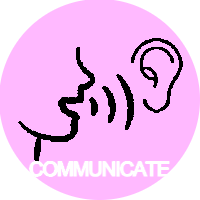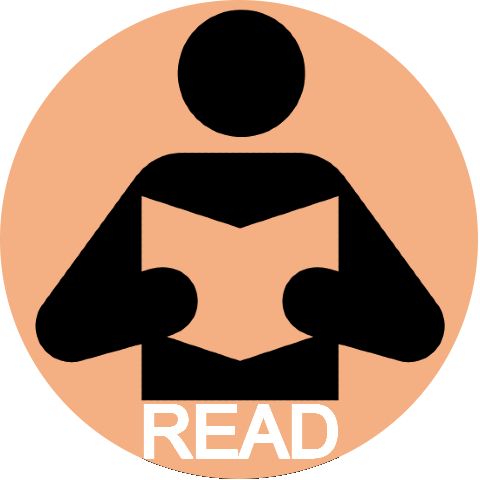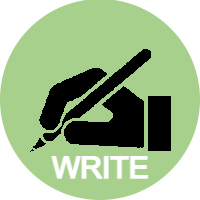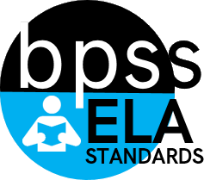ELA-11.C.02  | 11th (ELA) Targeted Standard (C) Communications (PC) Presentational Communication
Learners will organize and express information in a format appropriate to the audience and purpose.
|
ELA-11.C.02 Implement proper verbal and nonverbal communication for the task and situation.
 Proficiency Scale Proficiency Scale
Progressions
Standard C.02: Giving Oral Presentations - ELA-00.C.02 Speak audibly to express thoughts, feelings, and ideas.
- ELA-01.C.02 Speak audibly in complete sentences to express thoughts, feelings, and ideas.
- ELA-02.C.02 Speak audibly in complete sentences when proper to the task and situation to provide requested details or clarifications.
- ELA-03.C.02 Speak in complete sentences using proper eye contact and volume to express thoughts, feelings, and ideas.
- ELA-04.C.02 Present ideas using proper eye contact, body language, and volume in formal and informal situations.
- ELA-05.C.02 Present ideas using proper eye contact, body language, and volume in formal and informal situations.
- ELA-06.C.02 Present ideas using proper eye contact, body language, volume, and pronunciation in formal and informal presentations.
- ELA-07.C.02 Present ideas using proper eye contact, body language, volume, and pronunciation in formal and informal presentations.
- ELA-08.C.02 Present ideas using proper eye contact, body language, volume, and pronunciation in formal and informal presentations.
- ELA-09.C.02 Implement proper verbal and nonverbal communication for tasks and situations.
- ELA-10.C.02 Implement proper verbal and nonverbal communication for tasks and situations.
- ELA-11.C.02 Implement proper verbal and nonverbal communication for the task and situation.
- ELA-12.C.02 Implement proper verbal and nonverbal communication for the task and situation.
|
|
ELA-11.C.05

|
11th (ELA) Targeted Standard
(C) Communications
(C) Collaboration
Learners will engage in a range of discussions with various partners on relevant topics, texts, and issues.
|
ELA-11.C.05 Prepare for discussions by reading and researching ideas.
 Proficiency Scale Proficiency Scale
Progressions
Standard C.05: Preparations for Discussions
- ELA-06.C.05 Prepare for discussions by finding relevant connections to the topic or text.
- ELA-07.C.05 Prepare for discussions by finding relevant and specific connections to the topic or text.
- ELA-08.C.05 Prepare for discussions by finding relevant and specific connections to the topic or text.
- ELA-09.C.05 Prepare for discussions by reading and researching ideas to be discussed.
- ELA-10.C.05 Prepare for discussions by reading and researching ideas to be discussed.
- ELA-11.C.05 Prepare for discussions by reading and researching ideas.
- ELA-12.C.05 Prepare for discussions by reading and researching ideas.
|
|
ELA-11.C.06

|
11th (ELA) Targeted Standard
(C) Communications
(C) Collaboration
Learners will engage in a range of discussions with various partners on relevant topics, texts, and issues.
|
ELA-11.C.06 Engage in respectful discussions or debates.
 Proficiency Scale Proficiency Scale
Sub-Standards
- (a.) Listen to acknowledge varying perspectives and evaluate the speaker’s logic or argument.
- (b.) Critique the presentation of ideas.
- (c.) Present or share synthesized research and information.
- (d.) Ask and respond to questions to propel discussion.
Progressions
Standard C.06: Group Discussion and Debate
- ELA-00.C.06 Participate in conversations by listening to others and taking turns speaking.
- ELA-01.C.06 Participate in conversations by listening to others and taking turns speaking about topics, continuing through multiple exchanges.
- ELA-02.C.06 Participate in conversations by linking comments to the remarks of others and asking questions.
- ELA-03.C.06 Engage in conversations by asking and answering questions using active listening skills.
- ELA-04.C.06 Engage in a range of discussions by using active listening skills, posing, and responding to specific questions.
- ELA-05.C.06 Engage in a range of discussions using active listening skills, posing and responding to specific questions to clarify information.
- ELA-06.C.06 Engage in a range of discussions and/or debates using active listening skills to be focused and present.
- ELA-07.C.06 Engage in a range of discussions and/or debates.
- ELA-08.C.06 Engage in a range of discussions and/or debates.
- ELA-09.C.06 Engage in respectful discussions or debates.
- ELA-10.C.06 Engage in respectful discussions or debates.
- ELA-11.C.06 Engage in respectful discussions or debates.
- ELA-12.C.06 Engage in respectful discussions or debates.
|
|
ELA-11.C.07  | 11th (ELA) Targeted Standard (C) Communications (C) Collaboration
Learners will engage in a range of discussions with various partners on relevant topics, texts, and issues.
|
ELA-11.C.07 Collaborate on a specific task or purpose in a productive climate by establishing and following norms, processes, and roles.
 Proficiency Scale Proficiency Scale
Progressions
Standard C.07: Group Collaboration
- ELA-00.C.07 Work collaboratively by following agreed-upon rules and simple one- and two-step oral directions.*
- ELA-01.C.07 Work collaboratively by following agreed-upon rules and simple two- and three-step oral directions and offering one- and two-step verbal directions.
- ELA-02.C.07 Work collaboratively by following agreed-upon rules and following/offering multi-step oral directions.
- ELA-03.C.07 Engage collaboratively by following agreed-upon rules.
- ELA-04.C.07 Engage collaboratively to accomplish a common goal or purpose.
- ELA-05.C.07 Engage collaboratively to accomplish a common goal or purpose.
- ELA-06.C.07 Collaborate cooperatively with peers to accomplish a common goal or purpose.
- ELA-07.C.07 Collaborate cooperatively with peers to accomplish a common goal or purpose.
- ELA-08.C.07 Collaborate cooperatively with peers to accomplish a common goal or purpose.
- ELA-09.C.07 Collaborate on a specific task or purpose in a productive climate by following norms, processes, and roles.
- ELA-10.C.07 Collaborate on a specific task or purpose in a productive climate by following norms, processes, and roles.
- ELA-11.C.07 Collaborate on a specific task or purpose in a productive climate by establishing and following norms, processes, and roles.
- ELA-12.C.07 Collaborate on a specific task or purpose in a productive climate by establishing and following norms, processes, and roles.
|
|
ELA-11.IR.04  | 11th (ELA) Targeted Standard (IR) Inquiry and Research (S4) Determining Credibility and Evaluating Sources
Learner determines credibility and evaluates sources for research.
|
ELA-11.IR.04 Evaluate the credibility of a source based on bias, argumentative reasoning, perspective, and purpose.
 Proficiency Scale Proficiency Scale
Progressions
Standard IR.04: (begins in third grade)- ELA-03.IR.04 Identify a fact or an opinion based on information provided by the author.
- ELA-04.IR.04 Determine a fact or opinion based on information provided by the author.
- ELA-05.IR.04 Identify facts and multiple perspectives from credible sources.
- ELA-06.IR.04 Analyze information from credible sources considering multiple perspectives.
- ELA-07.IR.04 Analyze information from credible sources considering multiple perspectives and identifying biases.
- ELA-08.IR.04 Analyze the credibility of a source based on bias, perspective, and purpose.
- ELA-09.IR.04 Evaluate the credibility of a source based on bias, perspective, and purpose.
- ELA-10.IR.04 Evaluate the credibility of a source based on bias, perspective, and purpose.
- ELA-11.IR.04 Evaluate the credibility of a source based on bias, argumentative reasoning, perspective, and purpose.
- ELA-12.IR.04 Evaluate the credibility of a source based on bias, argumentative reasoning, perspective, and purpose.
|
|
ELA-11.IR.05

|
11th (ELA) Targeted Standard
(IR) Inquiry and Research
(S5) Citing Sources
Learner cites sources for research.
|
ELA-11.IR.05 Integrate information from sources using a standardized format.
 Proficiency Scale Proficiency Scale
Sub-Standards
- (a.) Reference sources for quotations, paraphrases, and/or summaries to avoid plagiarism and maintain academic integrity.
- (b.) Generate a citation/bibliography page using a discipline-specific format.
Progressions
Standard IR.05: (begins in fourth grade)
- ELA-04.IR.05 Cite and reference sources with a bibliography page using an approved citation format to avoid plagiarism.
- ELA-05.IR.05 Cite and reference sources with a bibliography page using an approved citation format to avoid plagiarism.
- ELA-06.IR.05 Integrate information from sources using a standardized format.
- ELA-07.IR.05 Integrate information from sources using a standardized format.
- ELA-08.IR.05 Integrate information from sources using a standardized format.
- ELA-09.IR.05 Integrate information from sources using a standardized format.
- ELA-10.IR.05 Integrate information from sources using a standardized format.
- ELA-11.IR.05 Integrate information from sources using a standardized format.
- ELA-12.IR.05 Integrate information from sources using a standardized format.
|
|
ELA-11.R.02  | 11th (ELA) Targeted Standard (R) Reading (C) Comprehension
Learners will read to understand a variety of complex literary and informational texts.
|
ELA-11.R.02 Comprehend a variety of texts with multiple levels of complexity while developing inferences and providing relevant textual evidence and reasoning.
 Proficiency Scale Proficiency Scale
Progressions
Standard R.02: Text Comprehension/Inferences- ELA-00.R.02 Respond to a variety of texts, photographs, or illustrations before, during, and after shared reading or other text-listening experiences to compare, contrast, predict, or infer.
- ELA-01.R.02 Ask and answer questions about a variety of texts, genres, photographs, or illustrations before, during, and after shared reading or other text-listening experiences to compare, contrast, predict, or infer.
- ELA-02.R.02 Ask and answer questions about key details before, during, and after reading a variety of literary and informational texts to compare, contrast, predict, or infer.*
- ELA-03.R.02 Ask and answer questions about key details before, during, and after reading a variety of genres, literary, and informational texts using text evidence to compare, contrast, predict, and infer.*
- ELA-04.R.02 Make inferences while reading a variety of genres, literary, and informational texts; providing text evidence.*
- ELA-05.R.02 Make inferences drawn from the text during and after reading a variety of genres, literary, and informational texts.*
- ELA-06.R.02 Comprehend a variety of texts while developing inferences and providing supportive textual evidence.
- ELA-07.R.02 Comprehend a variety of texts while developing inferences and providing supportive textual evidence and reasoning.
- ELA-08.R.02 Comprehend a variety of texts while developing inferences and providing relevant textual evidence and reasoning.
- ELA-09.R.02 Comprehend a variety of texts with multiple levels of complexity while developing inferences and providing relevant textual evidence and reasoning.
- ELA-10.R.02 Comprehend a variety of texts with multiple levels of complexity while developing inferences and providing relevant textual evidence and reasoning.
- ELA-11.R.02 Comprehend a variety of texts with multiple levels of complexity while developing inferences and providing relevant textual evidence and reasoning.
- ELA-12.R.02 Comprehend a variety of texts with multiple levels of complexity while developing inferences and providing relevant textual evidence and reasoning.
|
|
ELA-11.R.03a  | 11th (ELA) Targeted Standard (R) Reading (C) Comprehension
Learners will read to understand a variety of complex literary and informational texts.
|
ELA-11.R.03a Summarize and/or paraphrase nonfiction texts objectively, including relevant information.
 Proficiency Scale Proficiency Scale
Progressions
Standard R.03a: Summarizing Nonfiction Text- ELA-00.R.03a Tell about the informational text, photographs, or illustrations before, during, or after a shared reading or other text-listening experience.*
- ELA-01.R.03a Identify the topic of an informational text, photograph, or illustration during or after a shared reading or other text-listening experiences.*
- ELA-02.R.03a Identify the main idea with supporting details during or after reading an informational text or passage.*
- ELA-03.R.03a Summarize the main idea(s) with supporting details during or after reading an informational text or passage.*
- ELA-04.R.03a Summarize an informational text or passage, stating the main idea(s) and providing supporting details.*
- ELA-05.R.03a Summarize an informational text or passage, stating the main idea(s) and providing supporting details.*
- ELA-06.R.03a Summarize nonfiction texts objectively, including relevant details.
- ELA-07.R.03a Summarize and/or paraphrase nonfiction texts objectively, including relevant details and avoiding unnecessary information.
- ELA-08.R.03a Summarize and/or paraphrase nonfiction texts objectively, including relevant details and avoiding unnecessary information.
- ELA-09.R.03a Summarize and/or paraphrase nonfiction texts objectively, including relevant information.
- ELA-10.R.03a Summarize and/or paraphrase nonfiction texts objectively, including relevant information.
- ELA-11.R.03a Summarize and/or paraphrase nonfiction texts objectively, including relevant information.
- ELA-12.R.03a Summarize and/or paraphrase nonfiction texts objectively, including relevant information.
|
|
ELA-11.R.03b  | 11th (ELA) Targeted Standard (R) Reading (C) Comprehension
Learners will read to understand a variety of complex literary and informational texts.
|
ELA-11.R.03b Summarize and paraphrase literary texts objectively, including relevant information.
 Proficiency Scale Proficiency Scale
Progressions Standard R.03b: Summarize Literary Text- ELA-00.R.03b Tell about characters and setting in a literary text during or after a shared reading or other text-listening experience.*
- ELA-01.R.03b Identify characters, setting, and plot in a literary text during or after a shared reading or other text-listening experience.*
- ELA-02.R.03b Retell the plot to include the beginning, middle, and end of a literary text after reading.*
- ELA-03.R.03b Summarize the story by including major story elements after reading a literary text or passage.*
- ELA-04.R.03b Summarize the story by including major story elements after reading a literary text or passage.*
- ELA-05.R.03b Summarize a story by including major story elements after reading a literary text.*
- ELA-06.R.03b Summarize literary texts objectively, including relevant details.
- ELA-07.R.03b Summarize and/or paraphrase literary texts objectively, including relevant details and avoiding unnecessary information.
- ELA-08.R.03b Summarize and/or paraphrase literary texts objectively, including relevant details and avoiding unnecessary information.
- ELA-09.R.03b Summarize and/or paraphrase literary texts objectively, including relevant information.
- ELA-10.R.03b Summarize and/or paraphrase literary texts objectively, including relevant information.
- ELA-11.R.03b Summarize and paraphrase literary texts objectively, including relevant information.
- ELA-12.R.03b Summarize and paraphrase literary texts objectively, including relevant information.
|
|
ELA-11.R.04  | 11th (ELA) Targeted Standard (R) Reading (C) Comprehension
Learners will read to understand a variety of complex literary and informational texts.
|
ELA-11.R.04 Determine the main idea(s), claim(s), or theme(s) as they develop over the course of the text and interact with each other, and support them with textual evidence.
 Proficiency Scale Proficiency Scale
Progressions
Standard R.04: Main Idea/Claim/Theme- ELA-04.R.04 Identify a theme based on textual evidence.*
- ELA-05.R.04 Determine a claim or theme based on textual evidence.*
- ELA-06.R.04 Determine main idea(s), claim(s), or theme(s) and provide supporting textual evidence.
- ELA-07.R.04 Determine main idea(s), claim(s), or theme(s) and provide supporting textual evidence and reasoning.
- ELA-08.R.04 Determine a main idea(s), claim(s), or theme(s) and provide relevant textual evidence and supportive reasoning.
- ELA-09.R.04 Determine the main idea(s), claim(s), or theme(s) as they develop over the course of the text and support them with textual evidence.
- ELA-10.R.04 Determine the main idea(s), claim(s), or theme(s) as they develop over the course of the text and support them with textual evidence.
- ELA-11.R.04 Determine the main idea(s), claim(s), or theme(s) as they develop over the course of the text and interact with each other, and support them with textual evidence.
- ELA-12.R.04 Determine the main idea(s), claim(s), or theme(s) as they develop over the course of the text and interact with each other, and support them with textual evidence.
|
|
ELA-11.R.09

|
11th (ELA) Targeted Standard
(R) Reading
(TA) Text Analysis
Learners will analyze, interpret, and evaluate complex literary and informational texts that include a wide variety of genres and formats.
|
ELA-11.R.09 Analyze the development and interaction of informational and argumentative elements over the course of a nonfiction text and how they impact purpose using strong and thorough textual evidence to support the analysis.
 Proficiency Scale Proficiency Scale
Sub-Standards
- (a.) Analyze an author's point of view or purpose and possible biases in a text; compare texts from differing perspectives; and analyze how the author's style, content, characterization, and presentation support the author's purposes.
- (b.) Analyze and evaluate various accounts of a subject in different media, including determining which details are emphasized or omitted in each account.
- (c.) Delineate and evaluate how a text's argumentative reasoning, rhetorical techniques, and/or logical fallacies support or undermine the author's purpose and affect the audience.
Progressions Standard R.09: Synthesis and Analysis of Informational Text
- ELA-03.R.09 Determine the most important points and key details presented in two nonfiction texts on the same topic.
- ELA-04.R.09 Integrate information from two texts on the same topic.*
- ELA-05.R.09 Integrate information from several texts or media on the same informational topics.
- ELA-06.R.09 Analyze a variety of nonfiction texts using textual evidence for support.
- ELA-07.R.09 Analyze a variety of nonfiction texts using textual evidence for support.
- ELA-08.R.09 Analyze a variety of nonfiction texts using textual evidence for support.
- ELA-09.R.09 Analyze the development and interaction of informational and argumentative elements over the course of a nonfiction text and how they impact purpose using textual evidence to support the analysis.
- ELA-10.R.09 Analyze the development and interaction of informational and argumentative elements over the course of a nonfiction text and how they impact purpose using textual evidence to support the analysis.
- ELA-11.R.09 Analyze the development and interaction of informational and argumentative elements over the course of a nonfiction text and how they impact purpose using strong and thorough textual evidence to support the analysis.
- ELA-12.R.09 Analyze the development and interaction of informational and argumentative elements over the course of a nonfiction text and how they impact purpose using strong and thorough textual evidence to support the analysis.
|
|
ELA-11.wL.01

|
11th (ELA) Targeted Standard
(Wr) Writing
(LU) Language Usage
Learners will integrate appropriate language and style to ensure effective readability in writing.
|
ELA-11.wL.01 Apply language knowledge for a specific task, purpose, and audience, resolving issues of usage as needed.
 Proficiency Scale Proficiency Scale
Sub-Standards
- (a.) Use varying syntax (phrases, clauses, and sentence types) to convey specific meanings and add variety and interest.
- (b.) Recognize and choose between active and passive voice based on context.
- (c.) Use dashes, brackets, ellipsis, and other punctuation for advanced types and purposes of writing.
- (d.) Follow standard grammar conventions mastered in previous grades.
Progressions Standard wL.01: Language Mechanics (K-5)/Language Mechanics and Grammar (6-12)
- ELA-00.wL.01 Compose a simple sentence.*
- ELA-01.wL.01 Compose simple sentences.*
- ELA-02.wL.01 Compose simple and compound sentences.*
- ELA-03.wL.01 Compose simple and compound declarative, interrogative, imperative, and exclamatory sentences.*
- ELA-04.wL.01 Compose simple and compound declarative, interrogative, imperative, and exclamatory sentences.*
- ELA-05.wL.01 Compose simple, compound, and complex sentences.*
- ELA-06.wL.01 Apply language knowledge for a specific task, purpose, intention, and audience, resolving issues of usage as needed.
- ELA-07.wL.01 Apply language knowledge for a specific task, purpose, intention, and audience, resolving issues of usage as needed.
- ELA-08.wL.01 Apply language knowledge for specific tasks, purposes, intentions, and audience, resolving usage issues as needed.
- ELA-09.wL.01 Apply language knowledge for a specific task, purpose, intention, and audience, resolving issues of usage as needed.
- ELA-10.wL.01 Apply language knowledge for a specific task, purpose, intention, and audience, resolving issues of usage as needed.
- ELA-11.wL.01 Apply language knowledge for a specific task, purpose, and audience, resolving issues of usage as needed.
- ELA-12.wL.01 Apply language knowledge for a specific task, purpose, and audience, resolving issues of usage as needed.
|
|
ELA-11.Wr.02

|
11th (ELA) Targeted Standard
(Wr) Writing
(TTS) Text Types and Structure
Learners will engage in the writing process and produce a variety of texts determined to address different audiences and purposes.
|
ELA-11.Wr.02 Create a logical organizational structure with a relevant introduction, and transitional words or phrases to connect the major sections, paragraphs, plus sentences creating a unified whole, and an appropriate and thoughtful conclusion.
 Proficiency Scale Proficiency Scale
Progressions Standard Wr.02: Organizational Structure
- ELA-02.Wr.02 Write using an organizational structure that introduces a topic, includes supporting sentences, and provides a sense of closure.*
- ELA-03.Wr.02 Write using an organizational structure incorporating a topic sentence, body, and a concluding statement appropriate to the task.*
- ELA-04.Wr.02 Write using an organizational structure incorporating an introductory paragraph, a body, and a concluding section appropriate to the task.*
- ELA-05.Wr.02 Write using an organizational structure incorporating an introductory paragraph, multiple paragraphs (body), and a concluding section appropriate to the task.*
- ELA-06.Wr.02 Write using a clear organizational structure incorporating an introduction, transitions, body paragraph(s), and a conclusion appropriate to the task.
- ELA-07.Wr.02 Write using a clear organizational structure incorporating an introduction, transitions, body paragraph(s), and a conclusion appropriate to the task.
- ELA-08.Wr.02 Write using a clear organizational structure incorporating an introduction, transitions, body paragraph(s), and a conclusion appropriate to the task.
- ELA-09.Wr.02 Create a logical organizational structure with: relevant introduction, and transitional words or phrases to connect the major sections, paragraphs, and sentences, and an appropriate conclusion.
- ELA-10.Wr.02 Create a logical organizational structure with: relevant introduction, and transitional words or phrases to connect the major sections, paragraphs, and sentences, and an appropriate conclusion.
- ELA-11.Wr.02 Create a logical organizational structure with a relevant introduction, and transitional words or phrases to connect the major sections, paragraphs, plus sentences creating a unified whole, and an appropriate and thoughtful conclusion.
- ELA-12.Wr.02 Create a logical organizational structure with a relevant introduction, and transitional words or phrases to connect the major sections, paragraphs, plus sentences creating a unified whole, and an appropriate and thoughtful conclusion.
|
|
ELA-11.Wr.03

|
11th (ELA) Targeted Standard
(Wr) Writing
(TTS) Text Types and Structure
Learners will engage in the writing process and produce a variety of texts determined to address different audiences and purposes.
|
ELA-11.Wr.03 Write to inform an audience and to explain complex information by creating a clear thesis and providing supporting claims, details, and evidence from a variety of relevant and reliable sources within discipline-specific structures utilizing different mediums to provide clarity and context.
 Proficiency Scale Proficiency Scale
Progressions Standard Wr.03: Informative/Explanatory/Technical Writing Technique
- ELA-00.Wr.03 Draw and write informative pieces on a topic.
- ELA-01.Wr.03 Write informative pieces that detail the topic.
- ELA-02.Wr.03 Write informative pieces that include factual details on the topic.
- ELA-03.Wr.03 Write organized informative pieces that include factual details on the topic.
- ELA-04.Wr.03 Write organized informative pieces that include factual details on the topic.
- ELA-05.Wr.03 Write organized, informative pieces that include factual details on the topic.
- ELA-06.Wr.03 Write using informative/explanatory techniques to examine and convey complex ideas, concepts, and information utilizing different mediums when appropriate.
- ELA-07.Wr.03 Write using informative/explanatory techniques to examine and convey complex ideas, concepts, and information utilizing different mediums when appropriate.
- ELA-08.Wr.03 Write using informative/explanatory techniques to examine and convey complex ideas, concepts, and information utilizing different mediums when appropriate.
- ELA-09.Wr.03 Write to inform an audience and to explain complex information by creating a clear thesis and providing supporting claims, details, and evidence from a variety of relevant and reliable sources.
- ELA-10.Wr.03 Write to inform an audience and to explain complex information by creating a clear thesis and providing supporting claims, details, and evidence from a variety of relevant and reliable sources.
- ELA-11.Wr.03 Write to inform an audience and to explain complex information by creating a clear thesis and providing supporting claims, details, and evidence from a variety of relevant and reliable sources within discipline-specific
structures utilizing different mediums to provide clarity and context.
- ELA-12.Wr.03 Write to inform an audience and to explain complex information by creating a clear thesis and providing supporting claims, details, and evidence from a variety of relevant and reliable sources within discipline-specific
structures utilizing different mediums to provide clarity and context.
|
|
ELA-11.Wr.04

|
11th (ELA) Targeted Standard
(Wr) Writing
(TTS) Text Types and Structure
Learners will engage in the writing process and produce a variety of texts determined to address different audiences and purposes.
|
ELA-11.Wr.04 Write to persuade an audience.
 Proficiency Scale Proficiency Scale
Sub-Standards
- (a.) establishing relevant context,
- (b.) stating a clear position/thesis,
- (c.) incorporating valid and reliable evidence from a variety of sources to support specific claims and to refute counterclaims,
- (d.) using logical reasoning to avoid fallacies, and
- (e.) integrating rhetorical techniques and appeals.
Progressions Standard Wr.04: Opinion/Argumentative/Persuasive Techniques
- ELA-00.Wr.04 Draw and write opinion pieces on a topic.
- ELA-01.Wr.04 Write opinion pieces on a topic using a reason to support the opinion.
- ELA-02.Wr.04 Write opinion pieces on a topic using reasons to support the opinion.
- ELA-03.Wr.04 Write organized opinion pieces on a topic using evidence to support the opinion.
- ELA-04.Wr.04 Write organized argumentative pieces on a topic using evidence to support the claim.
- ELA-05.Wr.04 Write organized argumentative pieces on a topic using evidence to support the claim.
- ELA-06.Wr.04 Write using argumentative techniques to develop claims using supporting evidence and logical reasoning.
- ELA-07.Wr.04 Write using argumentative techniques to develop claims using supportive evidence and logical reasoning, acknowledging counterclaims when applicable.
- ELA-08.Wr.04 Write using argumentative techniques to develop claims and counterclaims using supporting evidence and logical reasoning.
- ELA-09.Wr.04 Write to persuade an audience
- ELA-10.Wr.04 Write to persuade an audience
- ELA-11.Wr.04 Write to persuade an audience
- ELA-12.Wr.04 Write to persuade an audience
|
|


 (C)
(C)
 (R)
(R)
 (Wr)
(Wr)
 (IR)
(IR)

